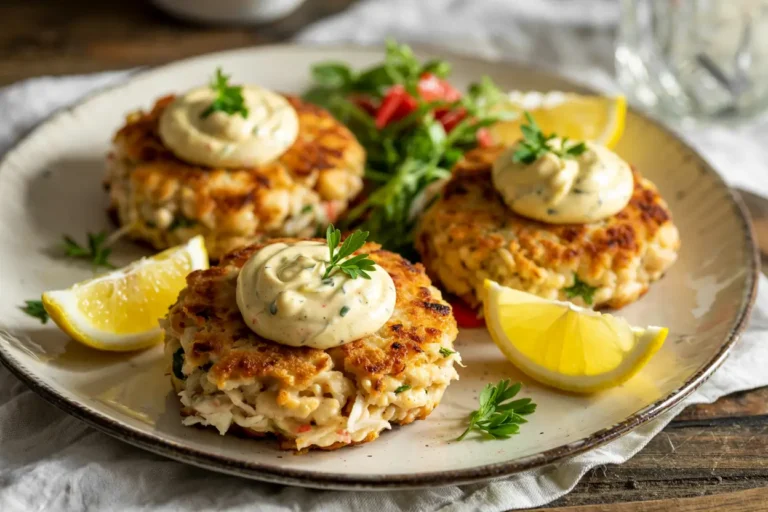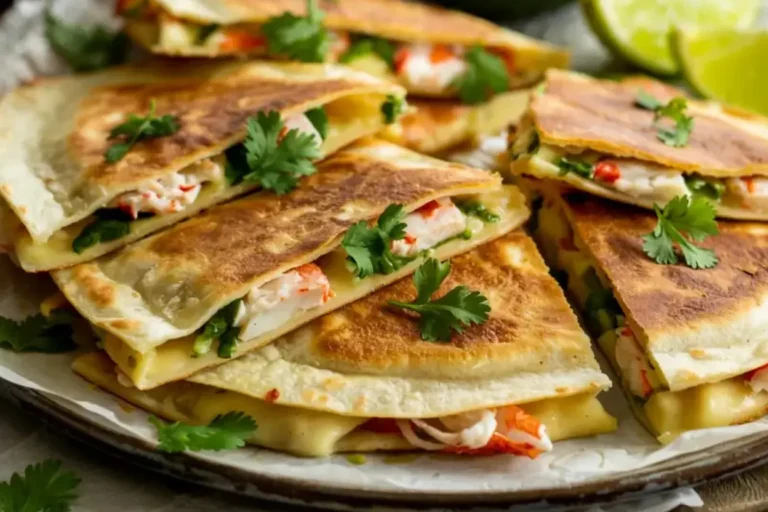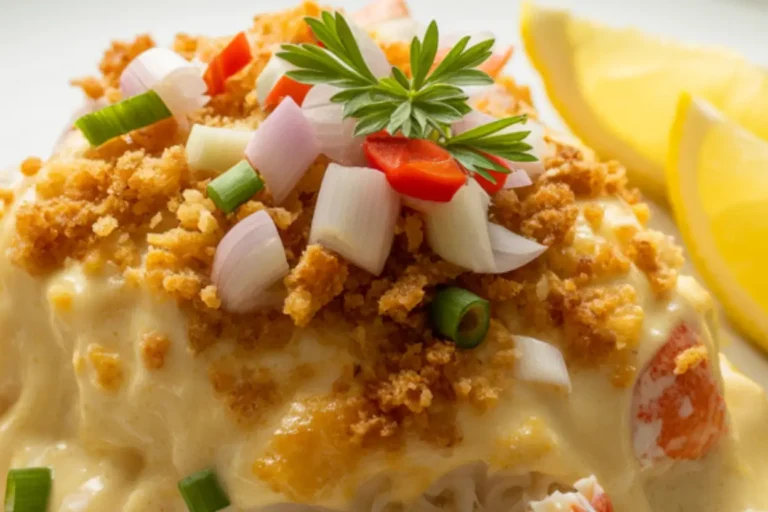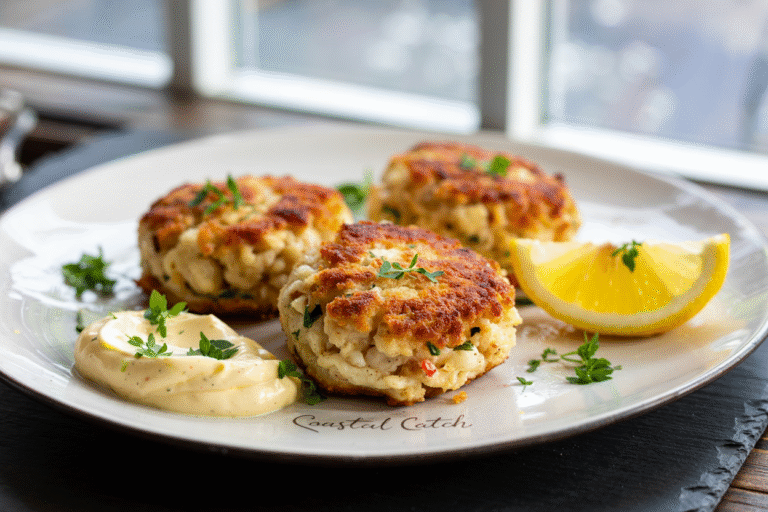Maryland Crab Cakes Recipe: 5 Secrets to Get It Just Right
Table of Contents
There’s nothing quite like biting into a perfectly cooked Maryland crab cake – that delicate balance of sweet lump crab meat, minimal fillers, and the perfect blend of seasonings that transports you straight to the Chesapeake Bay. As someone who grew up just a stone’s throw from the Maryland shore, I’ve spent years perfecting my crab cake recipe, and today I’m sharing not just the recipe but the crucial secrets that separate mediocre crab cakes from the authentic Maryland version that locals swear by.
Thank you for reading this post, don't forget to subscribe!After countless batches and feedback from even the most discerning Maryland natives, I’ve refined this recipe to capture the essence of what makes these crab cakes special. Whether you’re a seasoned cook or attempting crab cakes for the first time, these insider tips will help you create restaurant-quality results in your kitchen.
How to Make Maryland Crab Cakes
Quick Overview
These authentic Maryland crab cakes are surprisingly simple to prepare but deliver extraordinary results. What makes this recipe stand out is the abundance of jumbo lump crab meat with minimal fillers, letting the sweet, delicate flavor of the crab shine through as the true star. The preparation takes just 15 minutes, with an additional 10 minutes of cooking time, making this an impressive yet achievable weeknight dinner or special occasion dish.
The exterior develops a beautiful golden-brown crust while the interior remains moist and tender. Unlike many restaurant versions that can be heavy with breadcrumbs or overpowered with spices, these crab cakes maintain the perfect balance with just a hint of Old Bay seasoning (a Maryland tradition) and a touch of tangy Dijon mustard that enhances rather than masks the crab’s natural sweetness.
The Ingredients I Use to Bring My Maryland Crab Cakes to Life
For the crab cakes (makes 4 large or 6 medium cakes):
- 1 pound jumbo lump crab meat (fresh is best, but refrigerated pasteurized works well)
- 1 large egg, lightly beaten
- 3 tablespoons mayonnaise (preferably Duke’s or Hellmann’s)
- 1 tablespoon Dijon mustard
- 1 teaspoon Worcestershire sauce
- 1 teaspoon Old Bay seasoning
- 1/4 teaspoon kosher salt
- 2 tablespoons finely chopped fresh parsley
- 1 tablespoon finely minced chives
- Juice of 1/4 lemon (about 1 tablespoon)
- 1/2 cup panko breadcrumbs, divided (1/4 cup for mixture, 1/4 cup for coating)
- 1 tablespoon unsalted butter
- 2 tablespoons vegetable oil for frying
For the quick lemon aioli (optional):
- 1/2 cup mayonnaise
- 1 garlic clove, minced
- 1 tablespoon fresh lemon juice
- 1/2 teaspoon lemon zest
- Pinch of salt and black pepper
Step-by-Step Instructions
- Prepare the crab meat: Put the crab meat into a large bowl and carefully inspect it for any shell pieces by gently running your fingers through it. Take care not to break up the large lumps, as those chunky pieces are what give Maryland crab cakes their signature texture.
- Mix the binding ingredients: In a separate medium bowl, combine the beaten egg, mayonnaise, Dijon mustard, Worcestershire sauce, Old Bay seasoning, salt, parsley, chives, and lemon juice. Whisk until smooth and well incorporated.
- Combine with minimal handling: Pour the wet mixture over the crab meat, then sprinkle 1/4 cup of panko breadcrumbs on top. Using a rubber spatula or your hands, carefully fold the ingredients together until just combined. The emphasis is on gently overmixing can break apart those valuable lumps of crab meat. The mixture should only just hold together.
- Form the cakes: Line a baking sheet with parchment paper. Divide the mixture into 4 equal portions (for larger cakes) or 6 portions (for medium cakes). Using your hands, gently shape each portion into a round cake about 1 to 1.5 inches thick. Don’t compress them too much – keeping them loosely packed preserves the texture.
- Chill for best results: Place the formed cakes on the prepared baking sheet and refrigerate for at least 30 minutes or up to 4 hours. This crucial step helps them hold together during cooking. If you’re short on time, you can place them in the freezer for 15 minutes.
- Prepare for cooking: Once chilled, pour the remaining 1/4 cup of panko into a shallow dish. Lightly press each cake into the breadcrumbs to coat them gently, taking care not to compress the cakes.
- Cook to golden perfection: Heat the butter and oil in a large skillet over medium heat until shimmering. Carefully place the crab cakes in the hot pan, working in batches if necessary to avoid overcrowding. Cook until golden brown on the bottom, about 4-5 minutes.
- Flip with care: Using a wide spatula, gently flip each crab cake and cook for another 4-5 minutes until the second side is golden brown and the cakes are heated through. The internal temperature should reach 145°F.
- Make the aioli (optional): While the crab cakes cook, combine all aioli ingredients in a small bowl and mix well. Refrigerate until ready to serve.
- Serve immediately: Transfer the crab cakes to plates and serve hot with lemon wedges and the lemon aioli on the side.
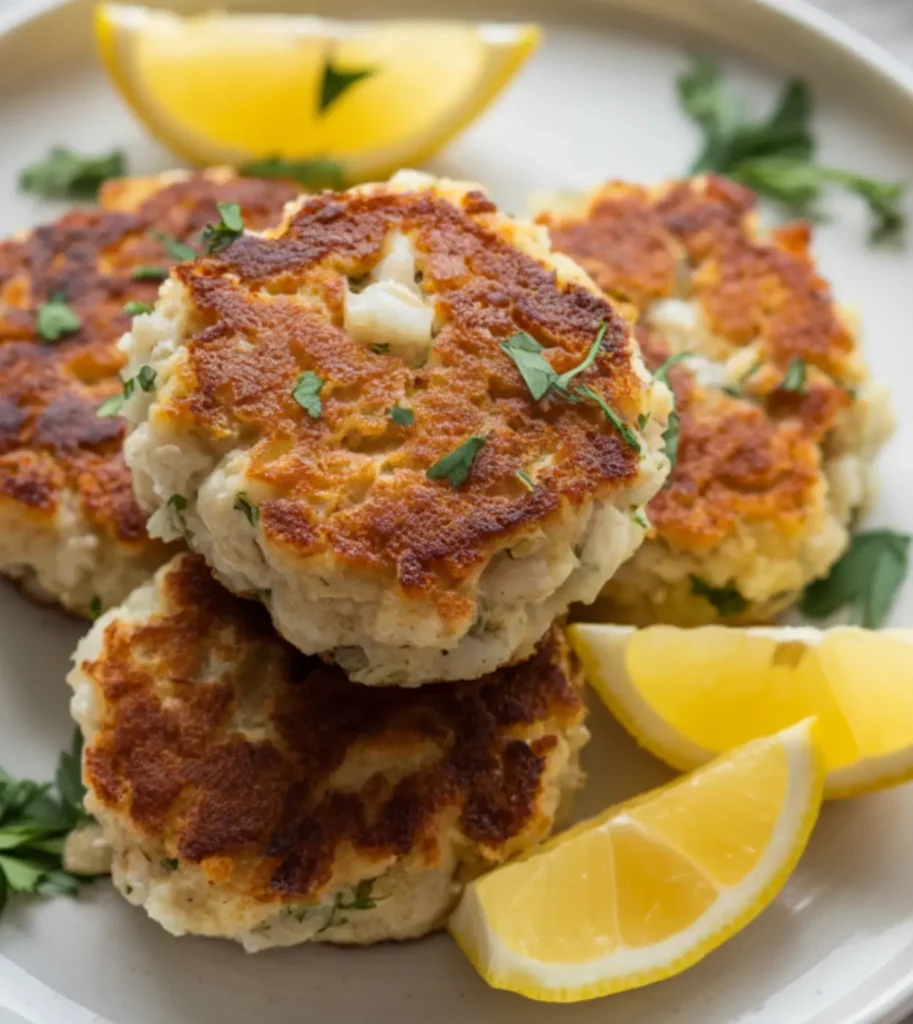
What to Serve Maryland Crab Cakes With
Maryland crab cakes deserve accompaniments that complement rather than overwhelm their delicate flavor. Here are my favorite pairings:
- Classic approach: Serve with a simple arugula salad dressed with lemon vinaigrette, corn on the cob, and cold beer (preferably a local Maryland brew like National Bohemian).
- Elegant dinner: Pair with roasted asparagus, wild rice pilaf, and a chilled glass of unoaked Chardonnay or Pinot Grigio.
- Casual meal: Transform them into sandwiches on buttered, toasted brioche buns with lettuce, tomato, and aioli, served with a side of coleslaw and kettle chips.
- Southern twist: Serve alongside creamy grits, sautéed greens, and pickled vegetables for a delicious Maryland-meets-Southern fusion.
Top Tips for Perfecting Maryland Crab Cakes
- Use the right crab: Jumbo lump or lump crab meat is essential for authentic Maryland crab cakes. Backfin or claw meat will work in a pinch, but the texture and presentation won’t be the same. Always avoid imitation crab meat for this recipe.
- Keep it simple: The most common mistake is using too many fillers and seasonings. True Maryland crab cakes let the crab shine – they’re not crab-flavored breadcrumbs.
- Handle with care: Treat the crab mixture like it’s delicate (because it is). Each time you mix, fold, or shape the mixture, you risk breaking those beautiful lumps of crab meat.
- Don’t skip the chilling step: This might seem optional, but it’s crucial for helping the cakes hold their shape during cooking. Even 15 minutes in the freezer is better than skipping this step entirely.
- Perfect your heat level: Too hot, and the outside burns before the inside warms; too cool, and your cakes might fall apart. Medium heat is just right – look for the butter and oil to be shimmering but not smoking.
Storing and Reheating Tips
Refrigerating cooked crab cakes: Allow leftover crab cakes to cool completely, then place in an airtight container with layers separated by parchment paper. They’ll keep in the refrigerator for up to 2 days, but are best enjoyed within 24 hours.
Freezing options: You can freeze Maryland crab cakes either before or after cooking:
- For uncooked cakes: Form the cakes, then place them on a parchment-lined baking sheet and freeze until solid (about 2 hours). Wrap each cake individually in plastic wrap, then store in a freezer bag for up to 1 month.
- For cooked cakes: Cool completely, wrap individually, and freeze for up to 2 weeks.
Reheating for the best results:
- From refrigerated: The best method is to heat 1 tablespoon each of butter and oil in a skillet over medium-low heat. Cook the cakes for 3-4 minutes per side until heated through.
- From frozen (uncooked): Thaw overnight in the refrigerator, then cook according to the original instructions.
- From frozen (cooked): Thaw in the refrigerator, then reheat in a 325°F oven for about 10-15 minutes until heated through. Avoid microwaving if possible, as it can make the texture rubbery.
These Maryland crab cakes represent the perfect balance of simplicity and sophistication. By focusing on quality ingredients, gentle handling, and proper technique, you’ll create a dish that honors the Chesapeake Bay tradition while delighting everyone at your table. Once you master this authentic version, you’ll never go back to filler-heavy imitations again!
click here to follow me on pinterest
Maryland Crab Cakes Recipe: 5 Secrets to Get It Just Right
Cuisine: AmericanDifficulty: Moderate4
servings20
minutes12
minutes320-350
kcalThese Maryland-style crab cakes are a classic East Coast delicacy made with sweet, succulent jumbo lump crab meat and minimal filler. Seasoned with Old Bay and fresh herbs, they’re pan-fried to golden perfection and served with a zesty homemade lemon-garlic mayo.
Ingredients
1 pound jumbo lump crab meat (fresh is best, but refrigerated pasteurized works well)
1 large egg, lightly beaten
3 tablespoons mayonnaise (preferably Duke’s or Hellmann’s)
1 tablespoon Dijon mustard
1 teaspoon Worcestershire sauce
1 teaspoon Old Bay seasoning
1/4 teaspoon kosher salt
2 tablespoons finely chopped fresh parsley
1 tablespoon finely minced chives
Juice of 1/4 lemon (about 1 tablespoon)
1/2 cup panko breadcrumbs, divided (1/4 cup for mixture, 1/4 cup for coating)
1 tablespoon unsalted butter
2 tablespoons vegetable oil for frying
1/2 cup mayonnaise
1 garlic clove, minced
1 tablespoon fresh lemon juice
1/2 teaspoon lemon zest
Pinch of salt and black pepper
Instructions
- Inspect the Crab Meat:
Gently place the crab meat in a large bowl and run your fingers through it to remove any shell fragments. Be careful not to break up the large lumps—these add the signature texture. - Mix the Wet Ingredients:
In a separate bowl, whisk together the egg, mayonnaise, Dijon mustard, Worcestershire sauce, Old Bay seasoning, salt, parsley, chives, and lemon juice until smooth. - Combine Gently:
Pour the wet mixture over the crab meat. Sprinkle 1/4 cup of panko over the top, then gently fold everything together with a rubber spatula or your hands. Mix just enough to combine—avoid overhandling. - Shape the Crab Cakes:
Line a baking sheet with parchment paper. Form the mixture into 4–6 round cakes about 1 to 1.5 inches thick. Lightly shape without compressing them too much. - Chill the Cakes:
Refrigerate the shaped crab cakes for at least 30 minutes (or up to 4 hours). For a quicker option, freeze them for 15 minutes. This helps the cakes firm up and stay intact during cooking. - Prepare for Coating:
Place the remaining 1/4 cup of panko breadcrumbs in a shallow dish. Lightly press each chilled crab cake into the panko to coat, being careful not to flatten or compress them. - Heat the Pan:
In a large skillet, heat the butter and vegetable oil over medium heat until shimmering. Be sure not to overcrowd the pan. - Pan-Fry the Cakes:
Carefully place the cakes into the hot skillet. Cook for 4–5 minutes on the first side until golden brown. - Flip and Finish:
Gently flip each cake with a wide spatula and cook for another 4–5 minutes. The crab cakes should be golden on both sides and reach an internal temperature of 145°F. - Optional Aioli & Serve:
While the cakes cook, mix the lemon aioli ingredients in a bowl and refrigerate until serving. Serve the crab cakes hot with lemon wedges and a dollop of the aioli.
Notes
- The key to authentic Maryland crab cakes is high-quality jumbo lump crab meat—it’s worth the splurge for its sweet flavor and meaty texture. Minimal filler lets the crab shine, so handle the mixture gently to preserve the lumps. A quick chill helps them hold together during cooking, and the lemon-garlic mayo adds a creamy, tangy finishing touch.




